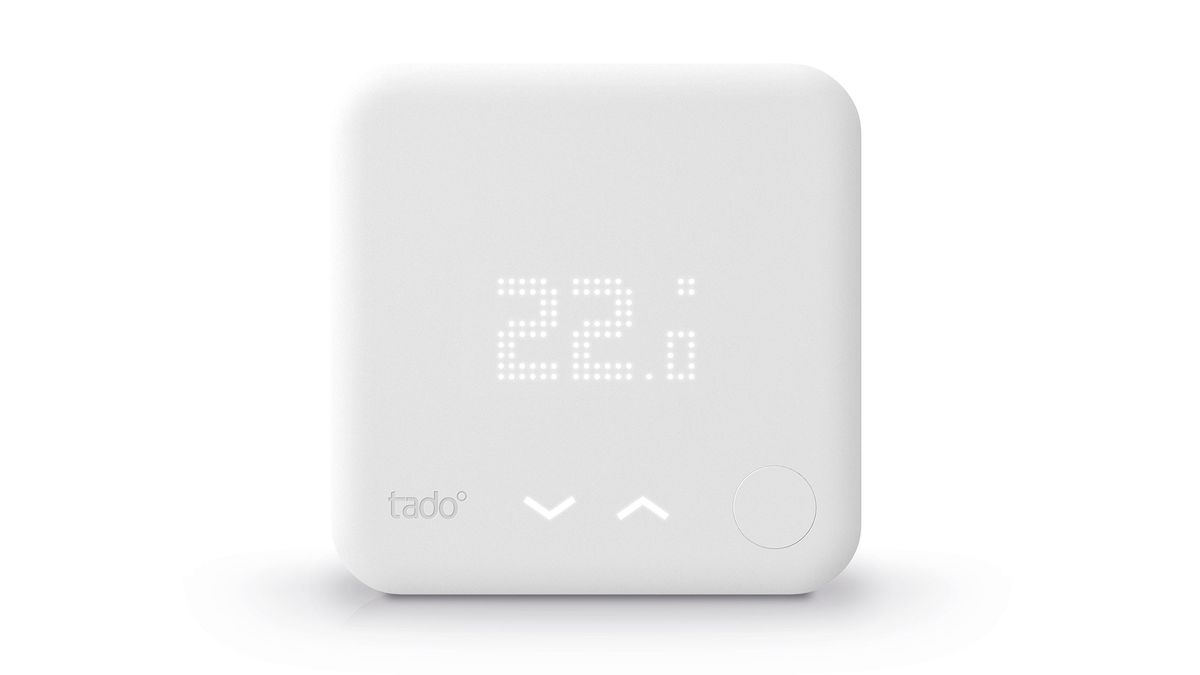TechRadar Verdict
Tado’s smart heating system includes not only a central thermostat, but also internet connected radiator valves that ensure that every room in your house is evenly heated, or not heated at all when it’s unoccupied. The functionality is expansive, but Tado’s system could certainly do with being a little more intuitive for the novice user.
Pros
- +
Radiator valves allow room-by-room control
- +
HomeKit and Alexa enabled
- +
Geo-fencing lets you avoid heating an empty home
Cons
- -
No motion-control
- -
Interface a little un-intuitive
- -
No self-learning capabilities
Why you can trust TechRadar
Smart heating has been the poster-child for the smart home since Nest burst onto the scene in 2011, and since then companies like Tado have taken the technology far further.
Whereas Nest utilises a single thermostat that’s only capable of reading the temperature in one room and adjusting the whole house’s heating, Tado’s system adds a series of internet-connected radiator valves to read and adjust your heating across all the rooms in your house.
It’s a phenomenally feature-packed system, especially if you combine it with the system’s HomeKit integration, making it one of the best smart thermostats you can buy. You won’t find that your heating system fails to turn on just because the central thermostat is in the warmest part of your house, and nor will you waste money heating empty rooms.
- Best smart thermostat: heating your home using tech
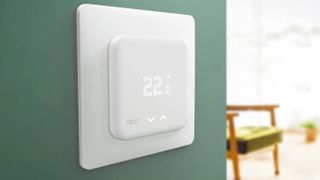
As a result of this efficiency, we found that the Tado heating system reduced our energy consumption by 15% over the winter months.
The energy saving aspects of the system are impressive, but we were a little less impressed with its control interface, which is more complicated than the competition.
Nevertheless, if you’re prepared to invest the time it takes to learn how to use the system to its fullest, and the money it costs to equip your whole house with the hardware, then you’ll find Tado to be an investment worth making, for the environment if not directly for your own wallet.
Price and availability
At present the Tado Smart Thermostat is only available in the UK and select European countries. The Tado Cooling system which controls AC systems is available in the US and Australia, so the Smart Thermostat may one day make its way to those countries too.
In terms of price, it will really depend on how many radiators you have. The starter kit is £199, and includes the internet bridge and the Smart Thermostat. Then each additional radiator thermostat is £59.
Installation and setup
For our test we went with a complete Tado installation consisting of a central Smart Thermostat aided by four Smart Radiator Thermostats. This would ensure that the upstairs rooms (which tend to be a lot colder than the rest of the flat) could be heated in line with the rest of the building.
This left just two valve-equipped radiators in our home without the Tado radiator valves. We chose to not install these on the radiators in our kitchen and living room since they’re the most likely to be the same temperature as the hallway where the central Thermostat is.
Although Tado advertises that you can easily install all its equipment yourself, we opted to have a certified installer come to get us set up. This can be organised through Tado’s website.
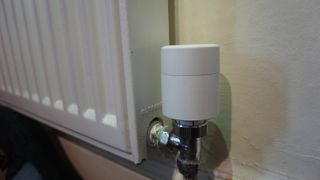
When the installer arrived it was a fairly simple process to unequip our last thermostat, and get Tado’s system hooked up. The only time-consuming part of the process was getting the individual radiator thermostats hooked up to the system (since this required us, the user, assigning them each to a room on the app), but the whole installation was over in a couple of hours without too much hassle.
With the hardware installed we then needed to set up our heating schedules, and this is where things got a lot more complicated.
Our previous heating system was a Nest thermostat. It was less advanced, and lacked individual radiator valves, but its ‘self-learning’ functionality meant that if you wanted to you could avoid setting it up entirely and just set it to the temperature that you wanted on a daily basis until it learnt your preferences.
However, the Tado lacks this functionality, which means that you have to set your schedules manually.
It’s important to remember that this setup will probably only need to be done once, with small adjustments made over time. When we initially reviewed this smart thermostat, we found it to be a little more frustrating than it needed to be with no option to easily copy one day’s, or one room’s schedule. This meant that we had to enter in the same information over and over, when it would have been far easier to set a schedule once, and then copy it across to all relevant days and rooms.
However, Tado has since rectified this and made it possible to copy schedules to make setting up the smart thermostat far easier.
Design
Compared to the Nest’s beautiful circular display and iPod-esque interface, Tado’s efforts don’t make as much of an impression.
The central thermostat is a fairly nondescript white square with a small button on the lower right which you use to wake it up and show you the current temperature.
Somewhat confusingly, the area to the left of the physical button is then used as a touchpad to raise and lower the temperature. This combination of physical and touch-sensitive controls confused our non-techie flatmates somewhat, and overall the experience of operating the thermostat was a little less intuitive than the Nest.
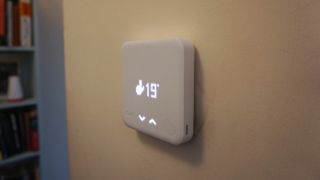
Thankfully the individual radiator valves are a lot easier to love and feel like a much more premium alternative to the ‘dumb’ valves we previously had installed. A sleek, featureless while cylinder while not in use, the units reveal a neat little LCD screen when you use them, which displays their current status.
Simply turn the satisfyingly clicky crown of the radiator valve and the LCD display will show you what temperature you’re setting the room to. It’s slick, it’s satisfying to use, and it’s obvious exactly what you need to do to get the desired result.
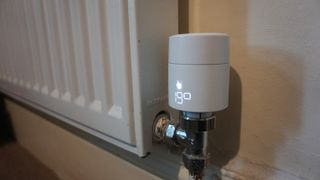
The final part of the system’s design is the app, which took us some getting used to.
We’ve already been through how setting up a heating schedule using the app is a bit of a pain, but we also found that there were other elements of the app that default to working in an unintuitive way.
If you want to change a room’s temperature using the app then typically you’ll head into the room’s section, and tap the section of the screen that shows the target temperature. In the iOS app this then brings up a fairly ugly default iOS interface, which you can then use to manually turn on the heating and pick a desired temperature.
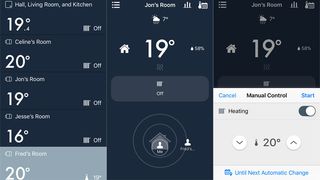
It sounds like a lot of steps and that’s because it is. It feels pointless manually turning the heating on when you also have to pick a temperature; surely the heating should automatically come on if you’re picking a temperature above what it currently is?
You’ll also have to be careful to turn the temperature back down when you no longer want the heating to be on, as the system defaults to changing the temperature ‘Until Ended by User’. We’d recommend that you change this to ‘Until Next Automatic Change’ to avoid accidentally leaving the heating on overnight.
We had our initial problems with the app, but it’s nothing that you can’t learn to live with. Be prepared to spend some time poking around to make sure you understand how everything works and that it’s all set up to behave as you expect it to and you shouldn’t experience any ongoing issues.
Features
We’ve already discussed many of Tado’s features such as the thermostat, radiator valves, and Tado app, but there are a couple of extra features that are worth touching upon.
The first is that Tado works with a number of third-party systems to add an extra layer of automation to your smart home. Tado supports all the major ecosystems including Alexa, Google Assistant, and IFTTT. The first two are great if you want to be able to control your heating using your voice, while the latter is a great way of pairing your heating with your other smart home devices to, for example, have your lights turn off when Tado senses that you’ve left the house.
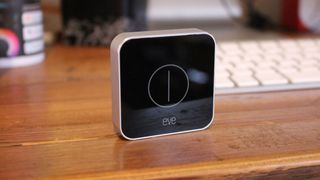
We were particularly impressed with the HomeKit integration, which is Apple’s smart home ecosystem. We set up an Elgato Eve Button to act as both a heating and lighting switch, so that we could instantly turn on both the (Tado-controlled) radiator and the (Philips Hue-enabled) light when we entered into a room.
Schedules are great, but having this functionality meant that we could set up certain rooms to only heat up on demand, and it felt very convenient.
The system occasionally suffered with the same kinds of limitations as other HomeKit-enabled devices with button-presses sometimes failing to register. It didn’t quite feel as reliable as an old-fashioned light switch, but the breadth of the functionality meant that we didn’t mind too much.
Disappointingly, Tado doesn’t include any form of motion-sensing in order to work out whether you’re at home or not – which you de get in the Hive system. It relies entirely upon your phone to know not to heat an empty home.
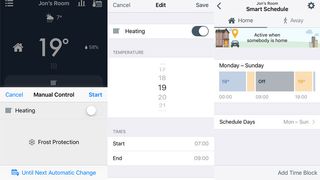
In other words, the system relies on every member of your household having the Tado app installed to work out when the house is empty (so it can avoid heating it) rather than detecting motion and adjusting the heating appropriately.
This could be an issue if there are any members of your household that don’t own phones (such as young children or technophobic housemates) who could find that the heating refuses to turn on if they’re home alone.
It would be great if you could set up the system to only heat up the rooms of the people who are home, but unfortunately this functionality isn’t available (this was another element that Tado assured us was on the roadmap for future integration).
Overall from a functional perspective the Tado system is strong. Room-by-room control is effective, and integration with external ecosystems means that the system should be able to work harmoniously with the rest of your gadgets. The only big missing feature is motion-detection, but depending on how you hope to use the system this might not be a huge concern to you.
Performance
While playing with all the bells and whistles of a smart heating system is fun, the real test is how much energy it saves you. In an ideal world you’d save enough energy using a system such as this to allow it to pay for itself, but we’re not quite at that point just yet.
By using the Tado system, we found that we saved just under 15% of our energy usage through the middle of winter versus our previous non-smart heating system. In comparison, Nest saved us 45% over the same period.
However, this information comes with some significant caveats, and your experience will vary a great deal depending on the layout of your home, how you’re used to using the heating, and the weather generally.
First, we should say that the weather was much colder the winter we had the Tado system installed. The Met Office recorded an average temperature of 4.6C in South England through 2017’s winter (our Tado test months), compared to 5.4C in 2016 (the year we had Nest installed), and 7C in 2015 (when we had no smart heating at all). This will have significantly impacted upon our energy usage over these three periods.
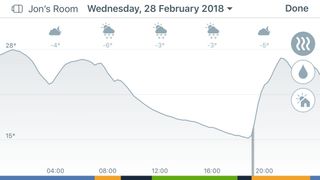
Secondly, our flat was much more comfortable when using Tado than when we used the Nest.
Our main thermostat is located downstairs, where it tends to be much warmer. Nest’s setup (which only records the temperature from one point in the home) was unable to recognise when it was cold upstairs, and hence wouldn’t turn the heating on.
This was good news for our heating bill, but not great for the people that ended up with cold bedrooms upstairs.
In contrast, Tado was much more consistent. The flat was heated evenly, and no one ended up with a cold bedroom. The downside of this is the slightly higher energy usage.
The amount of control Tado allows means that we could have probably saved more money if we’d tweaked our schedules a little more by paying closer attention to when people spent time in their rooms, but without the self-learning smarts of the Nest system this would have been a much more hands-on process than we would have liked.
Outside of energy usage, we had a couple of issues with the radiator valves. Just a few short months after we had the system installed, one of our radiator thermostats gave us a notification on the app to say that its battery was running low. Tado advertises that these valves should have enough battery life for up to two years of use.
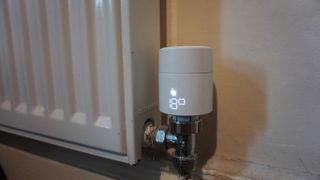
We replaced the battery, but a couple of weeks later found that the room was being consistently heated to a level far hotter than we’d specified. However, after a quick email to Tado their engineers were able to remotely detect that the valve was malfunctioning, and they sent us a replacement to install ourselves.
Another valve was suffering from a similar issue, but this was apparently a software fault that could be corrected remotely.
Tado comes with a two year warranty as standard, so we’d advise keeping a close eye on your room temperatures to ensure that nothing is malfunctioning. It obviously wasn’t ideal that two of our radiator thermostats developed faults, but Tado dealt with the issues quickly and easily.
Verdict
The pieces are all in place for the Tado smart heating system to provide an excellent, efficient heating system and for the most part it succeeds. However, there are a couple of problems that we experienced which are worth bearing in mind if you’re thinking of investing in the system.
We liked
An overall energy saving of 15% is excellent, but what’s more impressive is that Tado’s system managed to do this while keeping our flat feeling lovely and warm. We didn’t have to sacrifice any heat to save energy, and that feels like what smart heating should be all about.
The radiator valves are beautifully designed, and the app is easy to use once you know what you’re doing.
Integration with third-party services such as HomeKit and Google Assistant is an increasingly essential inclusion.
Geofencing is a good way of ensuring that you don’t waste money heating an empty home.
We disliked
There’s no way to have the system learn your preferences automatically as with the Nest thermostat.
The central thermostat is a little unintuitive to use because of its combination of a physical button and a touchscreen. Be prepared to explain how it works to other members of your household. The same is true of the app, which takes a little getting to know.
No motion-sensing capabilities mean that everyone in your household will need to install the Tado app on their phones in order for the system to know when the house is occupied.
We experienced some problems with the hardware, but Tado was more than willing to remotely diagnose the issue and send out replacement hardware as required.
Final verdict
There is no perfect smart heating system at the moment. Nest has the most intuitive interface but is hampered by no zonal heating support. Honeywell’s Evohome can control radiators individually, but lacks the integration with third-party services like HomeKit and Google Assistant that really allow you to expand its functionality.
Tado ticks so many of the right boxes, but its biggest fault is just that it’s a little unintuitive to set up and use for the first time. That said, it’s nothing that couldn’t be fixed via future software updates, and if you put the time in to learn how to best use the system then you’ll be rewarded with some nice energy savings while maintaining a beautifully warm house.
Jon Porter is the ex-Home Technology Writer for TechRadar. He has also previously written for Practical Photoshop, Trusted Reviews, Inside Higher Ed, Al Bawaba, Gizmodo UK, Genetic Literacy Project, Via Satellite, Real Homes and Plant Services Magazine, and you can now find him writing for The Verge.

Testing Samsung's new AI-powered vacuum taught me that I don't really need my vac to be know the difference between every single surface

I’ve used a lot of power banks, but the Baseus Blade Pro is the only one slim enough for my laptop sleeve

This is the world's first Thunderbolt 5 LTO tape drive and I can't understand why it exists in the first place
